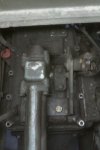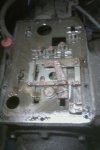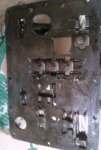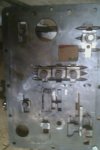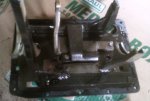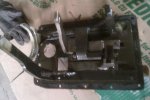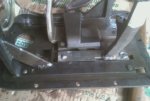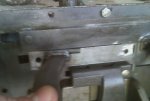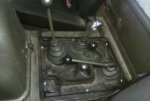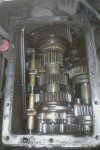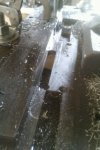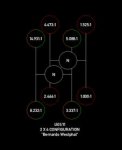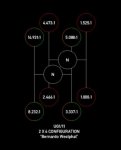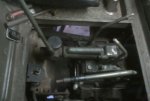spicergear
New member
- 2,307
- 28
- 0
- Location
- Millerstown, PA
I converted the 6 speed transmission in my Unimog 406 into an 8 speed!!! It’s a bit of work, but not too bad…it basically goes like this: You have the transmission cover with the shifters that you move for gear selection and the corresponding internal top part of the shift linkage. Then you have the shift plate which is sandwiched between the top of the transmission case and the shift cover. The shift plate has the slots for linkage travel, shift detents, all of the ‘shift logic’ on it, and all the shifting forks or bars that stick down into the transmission to slide the shift forks or other internal gear selection sliding parts that make the tranny do it’s thing.
On the 6 speed, you have 2 low range gears (known as ‘working gears’) then you have to stop, shift across a sometimes finicky shift gate into the 4 high speed gears. The shift gate is finicky because not only are you moving a lot of intricate linkage, you are also shifting from low to high range so that actual gear change must line up. Follow? There is also a high range lockout integrated with the shift logic so reverse cannot be accessed in high range. This sucks because when you’re normally street driving in 3rd – 6th and have to stop to back up; you need to shift back over into low range then back up, and then back across to high range to continue with any speed.
Now the Mogs like mine, 406/416’s, were outfitted with I think 6 different transmission options being 6, 8, 16, 20, 24, and 20 with torque converter…don’t quote me on those, it’s something like that. Soooo…what’s good for us (we 6 speed guys sick of that annoying low range notchy shift crap) is that the 6 and 8 speed transmissions are loaded with the SAME gears the only difference is basically the shift logic, shift plate, and top cover. The top cover has an extra shifter on the 8 speeds SPECIFICALLY for the HI to LO range shift instead of it being in the complicated 6 speed linkage. The 6 speed top covers have a fully machined mounting pad for the 8 speed HI – LO shifter with a block off plate bolted on. I found a guy that happened to have a NOS 8 speed HI – LO shifter and picked that up…they are NOT readily available. Oh, and the 20 speeds are 6 speeds with another gear box, called a ‘cascade box’ in front of them and are capable of 4,000:1 final drive ratio which translates to around 1,000ft per hr @ wide open throttle.
What I did for this conversion was pull the top cover which only needed the 8 speed shifter installed, and then pull the shift plate. That’s where it got a bit complicated…but still not too bad…more of a pain in the rump than anything. Most of what I had read was about a similar conversion for the 404’s though they usually do this through the PTO cover on those trucks. Some 406 stuff I had read had some good info but left out some critical nuances of this conversion that added some time and thought to the way of attacking the rest of the project.
ALL the 6 speed’s complicated ‘shift logic’ got removed. Let me tell you, if you had told me a year ago I would be attacking my transmission guts with a grinder, chisel, screwdriver (long chisel ), and hammer I would have laughed at you…not yesterday though. Ma’Benz puts these shift plates together to STAY together with 3/8 size (metric…you know) machined pins peened over on the bottom where the heavy sliding linkage of the shift plate engages the gear sets and machined on the top side for the detent hardware. You have to grind off the peened over area on the 2 pins that hold the HI – LO slider to the shift plate then, machine a .704” notch into the side of it so the new shifter, coming down from the top cover THROUGH the shift plate, has a slot to engage into- fairly simple…but the but slightly unexpected when realizing this was all put together in a very permanent fashion. Then I machined a slot into the shift plate .320” wide x about 2- 3/4” long so the 8 speed HI – LO shifter could access the lower HI – LO heavy slider and its new .704” notch. The slot was machined for full travel even though the shifter in the transmission won’t see that much…figured better safe than sorry since I’m already there. That slot width gives plenty of room too. The shift plate itself is a ¼” thick (metric…you know…) and about 12”x 16”… just guessing.
), and hammer I would have laughed at you…not yesterday though. Ma’Benz puts these shift plates together to STAY together with 3/8 size (metric…you know) machined pins peened over on the bottom where the heavy sliding linkage of the shift plate engages the gear sets and machined on the top side for the detent hardware. You have to grind off the peened over area on the 2 pins that hold the HI – LO slider to the shift plate then, machine a .704” notch into the side of it so the new shifter, coming down from the top cover THROUGH the shift plate, has a slot to engage into- fairly simple…but the but slightly unexpected when realizing this was all put together in a very permanent fashion. Then I machined a slot into the shift plate .320” wide x about 2- 3/4” long so the 8 speed HI – LO shifter could access the lower HI – LO heavy slider and its new .704” notch. The slot was machined for full travel even though the shifter in the transmission won’t see that much…figured better safe than sorry since I’m already there. That slot width gives plenty of room too. The shift plate itself is a ¼” thick (metric…you know…) and about 12”x 16”… just guessing.
I had a picture of an 8 speed shift plate for reference where the machined slot needed to be and eyeballed it from there…and also a picture of an 8 speed HI – LO slider and eyeballed the location of the notch it needed for the shifter to engage it. I got the 704” dimension from the rest of the lower heavy sliders. I installed the HI – LO shifter itself onto the top cover and measured where it was from the inside of the case or in from the side. Turned out that it looked to be about .020” or so into the next shift slider beside the HI – LO heavy slider which is for the reverser. While I had the shift plate locked down in my Bridgeport, I took a little material off of that reverse linkage slider to make sure the HI – LO shifter would have no interference.
Once the shift plate and HI – LO slider have been machined, they’re ready to go back together. Keep in mind you really, really want to reuse the pins you pushed or punched out after grinding the peened areas off of them earlier. I pressed them in tight, center punched around the edges to keep them tight, then cranked my Lincoln up to 135amps and united the pins with the heavy slider in permanent fashion. There are stepped blocks that insert into the slots in the shift plate that when all is tight- tight like factory; they have clearance already built into them so get them tight, fry’em in, and keep moving.
**In one of the descriptions I had read there was a picture of the 6 speed factory shift plate with the shift logic removed and all the machined ‘rivets’ that have a machined wedge head on the bottom side and then peened over on the top side of the shift plate holding on the 6 speed’s shift logic. I feel that picture for those on BenzWorld that view it may be a bit…well, it needs some more addressing… which is why I’m posting this; once the shift logic is removed there is the possibility that 3 and possibly 4 of those machined pins could eventually release from the holes in the shift plate and drop down into the transmission gears. The heavy sliders for all the gear movements positively capture and 100% retain 8 of the 12 pins with the 9th being 1/3 captured. I removed a few others while I had the HI – LO heavy slider out to machine the notch otherwise those would have been 100% retained too. They look to be a very light pressed or a tight tolerance fit from the factory but after prying off the shift logic, virtually all mine were loose to the touch. Cut ¼” off the head of a 10 penny nail and drop 3 or possibly 4 of them into your transmission?!? Not me.**
The final modification is to weld on a block off plate onto the top side of the shift plate covering where the original 1st & 2nd gear selection would be. I welded on a simple piece of ¼”x 1 bar stock a little under 3” long. All you need to be sure of is that it lines up with the one side of the ‘H’ that’s already there.
Okay, so why bother with all this hub-bub for the 8 speed. Simple; it makes it a MUCH more drivable transmission with the separate HI – LO range shifter as the 8 speeds are set up. You now have 4 working low range gears (as opposed to 2 in the 6 speed) and 4 high speed gears. The bonus is that the 3rd and 4th speeds in LO range overlap a little into your first HI speed gear by about a gear and a half…if that makes sense. I know on the trails it’s a HUGE pain in the rump when people start to go faster, I have to stop, knock across the sometimes clunky shift gate out of low into high, then start from a stop in 3rd gear, then when they get too slow, stop and knock across and range shift to low. With the 8 speed and the 4 available low speed gear AND them overlapping into the high range speeds, it very much simplifies driving and the whole transmission.
The transmission now is 8 forward speeds and 4 reverse speeds and the driver is quite happy with the result. The 2 more speeds in low range really, really is nice…and honestly will take a little to get used to. I’ve had the truck two years and just got used to running out of gear in low or having to deal with the original 3rd gear (the first speed in HI range) being sometimes too fast on the farm. This is really nice with the speed overlap and more gear selection. The ability to have 2 faster speeds in reverse is very, very nice as well. It’s also cool having another shifter for un-Mog-familiar passengers.
On the 6 speed, you have 2 low range gears (known as ‘working gears’) then you have to stop, shift across a sometimes finicky shift gate into the 4 high speed gears. The shift gate is finicky because not only are you moving a lot of intricate linkage, you are also shifting from low to high range so that actual gear change must line up. Follow? There is also a high range lockout integrated with the shift logic so reverse cannot be accessed in high range. This sucks because when you’re normally street driving in 3rd – 6th and have to stop to back up; you need to shift back over into low range then back up, and then back across to high range to continue with any speed.
Now the Mogs like mine, 406/416’s, were outfitted with I think 6 different transmission options being 6, 8, 16, 20, 24, and 20 with torque converter…don’t quote me on those, it’s something like that. Soooo…what’s good for us (we 6 speed guys sick of that annoying low range notchy shift crap) is that the 6 and 8 speed transmissions are loaded with the SAME gears the only difference is basically the shift logic, shift plate, and top cover. The top cover has an extra shifter on the 8 speeds SPECIFICALLY for the HI to LO range shift instead of it being in the complicated 6 speed linkage. The 6 speed top covers have a fully machined mounting pad for the 8 speed HI – LO shifter with a block off plate bolted on. I found a guy that happened to have a NOS 8 speed HI – LO shifter and picked that up…they are NOT readily available. Oh, and the 20 speeds are 6 speeds with another gear box, called a ‘cascade box’ in front of them and are capable of 4,000:1 final drive ratio which translates to around 1,000ft per hr @ wide open throttle.
What I did for this conversion was pull the top cover which only needed the 8 speed shifter installed, and then pull the shift plate. That’s where it got a bit complicated…but still not too bad…more of a pain in the rump than anything. Most of what I had read was about a similar conversion for the 404’s though they usually do this through the PTO cover on those trucks. Some 406 stuff I had read had some good info but left out some critical nuances of this conversion that added some time and thought to the way of attacking the rest of the project.
ALL the 6 speed’s complicated ‘shift logic’ got removed. Let me tell you, if you had told me a year ago I would be attacking my transmission guts with a grinder, chisel, screwdriver (long chisel
I had a picture of an 8 speed shift plate for reference where the machined slot needed to be and eyeballed it from there…and also a picture of an 8 speed HI – LO slider and eyeballed the location of the notch it needed for the shifter to engage it. I got the 704” dimension from the rest of the lower heavy sliders. I installed the HI – LO shifter itself onto the top cover and measured where it was from the inside of the case or in from the side. Turned out that it looked to be about .020” or so into the next shift slider beside the HI – LO heavy slider which is for the reverser. While I had the shift plate locked down in my Bridgeport, I took a little material off of that reverse linkage slider to make sure the HI – LO shifter would have no interference.
Once the shift plate and HI – LO slider have been machined, they’re ready to go back together. Keep in mind you really, really want to reuse the pins you pushed or punched out after grinding the peened areas off of them earlier. I pressed them in tight, center punched around the edges to keep them tight, then cranked my Lincoln up to 135amps and united the pins with the heavy slider in permanent fashion. There are stepped blocks that insert into the slots in the shift plate that when all is tight- tight like factory; they have clearance already built into them so get them tight, fry’em in, and keep moving.
**In one of the descriptions I had read there was a picture of the 6 speed factory shift plate with the shift logic removed and all the machined ‘rivets’ that have a machined wedge head on the bottom side and then peened over on the top side of the shift plate holding on the 6 speed’s shift logic. I feel that picture for those on BenzWorld that view it may be a bit…well, it needs some more addressing… which is why I’m posting this; once the shift logic is removed there is the possibility that 3 and possibly 4 of those machined pins could eventually release from the holes in the shift plate and drop down into the transmission gears. The heavy sliders for all the gear movements positively capture and 100% retain 8 of the 12 pins with the 9th being 1/3 captured. I removed a few others while I had the HI – LO heavy slider out to machine the notch otherwise those would have been 100% retained too. They look to be a very light pressed or a tight tolerance fit from the factory but after prying off the shift logic, virtually all mine were loose to the touch. Cut ¼” off the head of a 10 penny nail and drop 3 or possibly 4 of them into your transmission?!? Not me.**
The final modification is to weld on a block off plate onto the top side of the shift plate covering where the original 1st & 2nd gear selection would be. I welded on a simple piece of ¼”x 1 bar stock a little under 3” long. All you need to be sure of is that it lines up with the one side of the ‘H’ that’s already there.
Okay, so why bother with all this hub-bub for the 8 speed. Simple; it makes it a MUCH more drivable transmission with the separate HI – LO range shifter as the 8 speeds are set up. You now have 4 working low range gears (as opposed to 2 in the 6 speed) and 4 high speed gears. The bonus is that the 3rd and 4th speeds in LO range overlap a little into your first HI speed gear by about a gear and a half…if that makes sense. I know on the trails it’s a HUGE pain in the rump when people start to go faster, I have to stop, knock across the sometimes clunky shift gate out of low into high, then start from a stop in 3rd gear, then when they get too slow, stop and knock across and range shift to low. With the 8 speed and the 4 available low speed gear AND them overlapping into the high range speeds, it very much simplifies driving and the whole transmission.
The transmission now is 8 forward speeds and 4 reverse speeds and the driver is quite happy with the result. The 2 more speeds in low range really, really is nice…and honestly will take a little to get used to. I’ve had the truck two years and just got used to running out of gear in low or having to deal with the original 3rd gear (the first speed in HI range) being sometimes too fast on the farm. This is really nice with the speed overlap and more gear selection. The ability to have 2 faster speeds in reverse is very, very nice as well. It’s also cool having another shifter for un-Mog-familiar passengers.
Attachments
-
35.5 KB Views: 59
-
38.6 KB Views: 57
-
45.5 KB Views: 52
-
31.6 KB Views: 51
-
40.3 KB Views: 50
-
49.5 KB Views: 43
-
37.4 KB Views: 44
-
33.7 KB Views: 43
-
40.1 KB Views: 49
-
49.2 KB Views: 50


